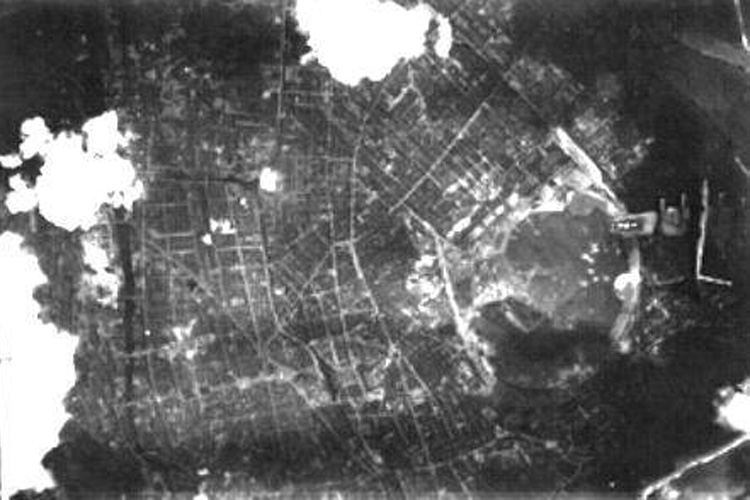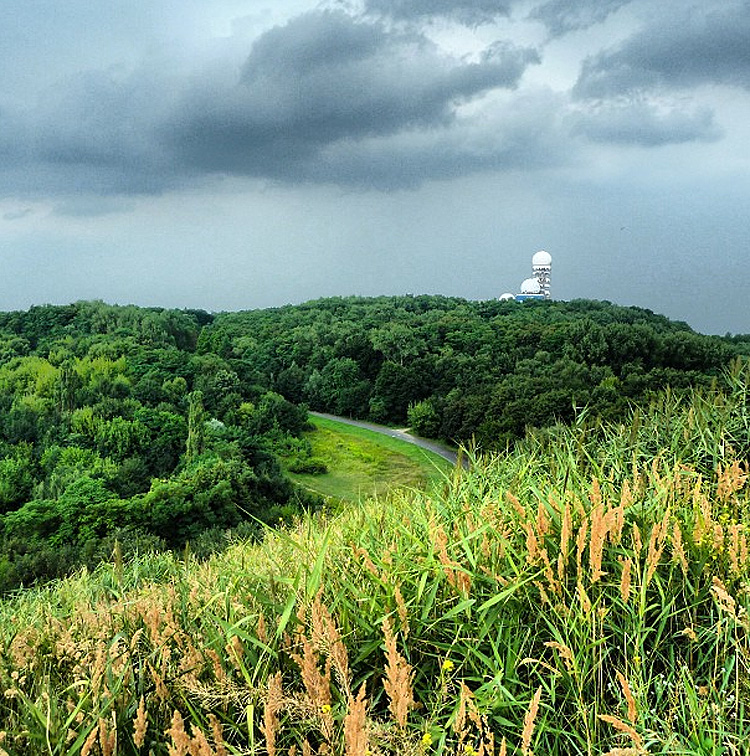
A startling example of adaptive re-use Berlin’s Teufelsberg (or Devil’s Mountain) provides Berlin with the best in all-season sports activity. Recognized among the premier spots for freeride mountain biking in Germany, these popular slopes rising from the forest of Grünewald also provide the very best snow sports, para-gliding and longboarding in Berlin, a modest claim at 377 feet above sea level. Still, as the highest point in the Berlin area it affords spectacular 360 degree visibility of city and surrounding countryside.
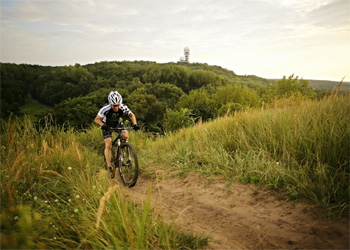

And that’s not all, in the divided Berlin of the Cold War the artificial mountain boasted the best in military intelligence audio technology, awarded four times the Travis Award by the United States NSA for superior Cryptologic Services. So effective, it is told, you could hear Brezhnev brushing his teeth!
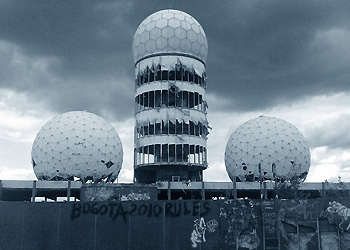

With a great back-to-the-future look, it’s composed of a vast complex including eight geodesic domes radomes covered in now-tattered plasticized denim, offering an incredible acoustical hum and dizzying unprotected views. Take an experiential renegade tour if you have 9 minutes. WARNING: Not for the acrophobic.
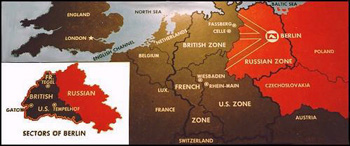 To station in West Berlin appears to have been good times for the occupying army as reported in the Berlin Observer (1945 to 1994), the local weekly of the U.S. Command. Requiring late nights, shared secrets and special skills in languages and paper-shredding, the staff at Field Station Berlin operating at Teufelsberg 1961-1991 included well-educated linguists and cryptologists, alumni of Monterey’s Defense Language Institute. Ridiculed as “Monterey Mary’s by the rest of the local troops, they appear to be a tight, trustworthy, literate group with fond memories expressed in vet blogs, book clubs and email groups. Station Vet T.H.E. Hill has developed both a website of memorabilia at Voice Under Berlin: the Tale of a Monterey Mary and a novel of same title which he himself compares favorably to Thomas Heller’s novel Catch 22 and and Robert Altman’s M*A*S*H–both novel and movie, hilarious and grim and recommended.
To station in West Berlin appears to have been good times for the occupying army as reported in the Berlin Observer (1945 to 1994), the local weekly of the U.S. Command. Requiring late nights, shared secrets and special skills in languages and paper-shredding, the staff at Field Station Berlin operating at Teufelsberg 1961-1991 included well-educated linguists and cryptologists, alumni of Monterey’s Defense Language Institute. Ridiculed as “Monterey Mary’s by the rest of the local troops, they appear to be a tight, trustworthy, literate group with fond memories expressed in vet blogs, book clubs and email groups. Station Vet T.H.E. Hill has developed both a website of memorabilia at Voice Under Berlin: the Tale of a Monterey Mary and a novel of same title which he himself compares favorably to Thomas Heller’s novel Catch 22 and and Robert Altman’s M*A*S*H–both novel and movie, hilarious and grim and recommended.
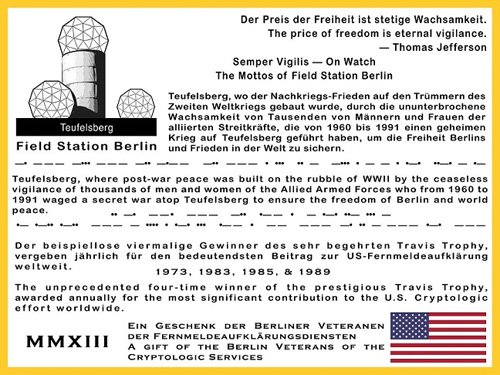 On Field Service Berlin Vet Group website you will find this certificate self-honoring their 50th Anniversary. In Morse Code are these messages: -. — -… — -.. -.– -.. — . … .. – -… . – – . .-. ..-. – .- “NOBODY DOES IT BETTER,” the title track to the James Bond movie The Spy Who Loved Me became a 1977 hit for Carly Simon. .. -. –. — -.. .– . – .-. ..- … – .- .-.. .-.. — – …. . .-. … .– . — — -. .. – — .-. — “IN GOD WE TRUST / ALL OTHERS WE MONITOR,” a popular phrase in military intelligence is widely available on baseball caps, coffee mugs and other memorabilia of various security administrations, such as our NSA. One hears its echo in Ronald Reagan’s chuckled communication to Mr. Gorbachev: “Trust but verify!”
On Field Service Berlin Vet Group website you will find this certificate self-honoring their 50th Anniversary. In Morse Code are these messages: -. — -… — -.. -.– -.. — . … .. – -… . – – . .-. ..-. – .- “NOBODY DOES IT BETTER,” the title track to the James Bond movie The Spy Who Loved Me became a 1977 hit for Carly Simon. .. -. –. — -.. .– . – .-. ..- … – .- .-.. .-.. — – …. . .-. … .– . — — -. .. – — .-. — “IN GOD WE TRUST / ALL OTHERS WE MONITOR,” a popular phrase in military intelligence is widely available on baseball caps, coffee mugs and other memorabilia of various security administrations, such as our NSA. One hears its echo in Ronald Reagan’s chuckled communication to Mr. Gorbachev: “Trust but verify!”
In a light-hearted version of the pathos-filled Christmas on the Western Front, stories tell of Field Station Berlin exchanging encoded Christmas Greetings and joke messages with their Soviet counterparts. Pictured below right, the fun-loving inhabitants of Field Station Berlin in the 1970’s; below left, the more serious Trummerfrau (rubble women) in late 1940’s separating stones and brick from ashes and bones. The servicemen and women on the left are standing atop the rubble collected by women and old men, Berlin’s survivors.
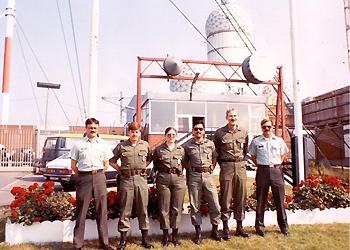
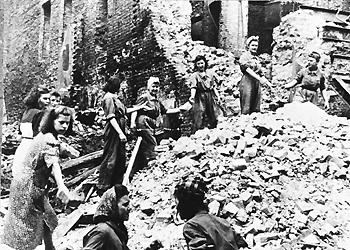
Notably, Teufelsberg and eight other hills in post-war Berlin are not natural geologic features at all but rubbish heaps gathered from the destruction of Berlin. Below the collection of rubble at the sectors’ borders and a similar Trummerberg at Tempelhof during the Berlin airlift of 1948.

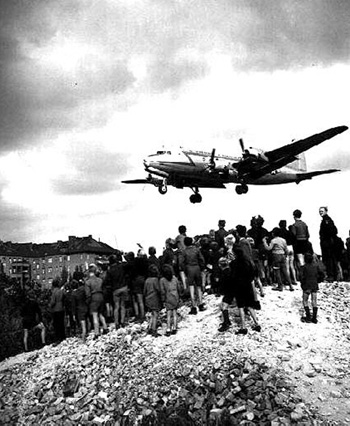
Digging deeper, beneath Teufelsberg’s rubble lies the beginnings of the Third Reich’s architectural vision for the new imperial Berlin. Hitler’s words:
- “Towards this holy belief I lay down the foundation for the Military Department of the Berlin College of Technology, as the first structure executed, out of which which will rise [our] plans [for the new imperial Berlin “Germania”]. And this shall become a monument to German culture, German knowledge and German strength. ” (“Zu dieser heiligen Überzeugung lege ich nun den Grundstein zur Wehrtechnischen Fakultät der Technischen Hochschule in Berlin als dem ersten Bauwerk, das im Vollzug dieser Pläne entsteht. Es soll ein Denkmal werden der deutschen Kultur, des deutschen Wissens und der deutschen Kraft.”)
The college turned out to be indestructible during the severe fire bombing of Berlin and was used instead as the foundation for piling rubble. The remains of Hitler’s urban vision now lie buried below Teufelsberg. Photo below, the Military College’s model followed by the image of debris-filled dump trucks, pulling up to the the ruins of the Military School.
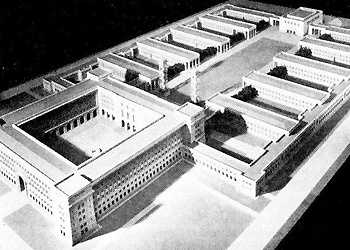
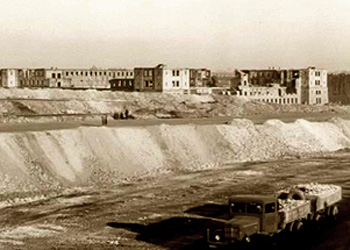
The bombing of Berlin continued for several years finally escalating to fire-bombing of civilian neighborhoods. Embedded war correspondent Edwin R. Murrow comments on his return from a bombing run:
- Berlin was a thing of orchestrated Hell – a terrible symphony of light and flames. It isn’t a pleasant kind of warfare – the men doing it speak of it as a job. Yesterday afternoon, when the tapes were stretched out on the big map all the way to Berlin and back again, a young pilot with old eyes said to me, “I see we’re working again tonight.” That’s the frame of mind in which the job is being done. The job isn’t pleasant; it’s terribly tiring. Men die in the sky while others are roasted alive in their cellars. Berlin last night wasn’t a pretty sight. In about 35 minutes it was hit with about three times the amount of stuff that ever came down on London in a night-long blitz. This is a calculated, remorseless campaign of destruction. Right now the mechanics are probably working on D-Dog [a British Lancaster plane], getting him ready to fly again.
Bruce Ford, webmaster for Field Station Berlin Veterans Group, posted the photo above his dad took of Berlin in 1944:
- “He [Dad] captioned this one in pencil on the back, “Seeing Europe courtesy of the 94th.” … I’d call it “Creating the rubble pile for Teufelsberg, April 1944.” I think this view is centered between the Panke River and the Sommerbad at Volkspark Humboldthain in Wedding Bezirke, just north of downtown Berlin.”
Since the fall of the Wall in 1989, and the US armies decommission, the structures of the former clandestine operation have flourished in abandon and decay, swarmed by vandals, taggers, squatters, scavengers, artists, photographers, musicians, bloggers, drunks, thrill seekers and former Listening Station staff.
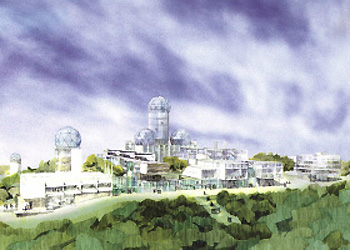 Passing from US NSA to Berlin Senate in 1992, Teufelsberg was then sold to a developer LLC affiliated with iGTB in 1996 and in 2005 restricted to forest use by Berlin zoning. The developers limited online presence leads to dead ends and techno-financial babble “enabling 360 swivel views and transaction-level drill downs”. Their unrealized vision of Teufelsberg as a resort Shangri-la is presented at left.
Passing from US NSA to Berlin Senate in 1992, Teufelsberg was then sold to a developer LLC affiliated with iGTB in 1996 and in 2005 restricted to forest use by Berlin zoning. The developers limited online presence leads to dead ends and techno-financial babble “enabling 360 swivel views and transaction-level drill downs”. Their unrealized vision of Teufelsberg as a resort Shangri-la is presented at left.
At this point the secret and mystery of Teufelsberg becomes vaporized in a google haze of increasing information glut. Comments on Irisher Berliner’s abandonedberlin provide weekly chatter on access, crowds and security. As one surveys archived web photos from 1995 to the present, the year to year degradation of the structure by vandals, tagging and scavengers is striking. The structures have changed from abandoned to damaged, the images from curious documentation to moody ruin porn. The resultant cultural, artistic and searing emotional impact of these ruined, risky structures is clearly evident in testimony and video.
Chain link, barbed wire and EINTRITT VERBOTEN signs, an attraction to 20 years of visitors, have proved inadequate to the interests of Station preservationists, Owners and trespassers’ safety. Seeing an opportunity in the inadequacies, entrepreneur Shalmon Abraham created a career niche in 2012. In exchange for sole tour rights to the station, he provides security and maintenance with a sketchy and sporadic mercenary army of guards and guides. Chloe comments on abandonedberlin in August 2013
- “These ‘people’ were parked in some shitty looking boyracer car- two young fellas in their early 20s. My German freund got talking to them- and they said they worked there. Their job was to guard the gate from their car. They smoked cigarettes and played on their iphones, like all nice mobsters do. They told us they worked for their ‘boss’ who ‘leased the place from the government’. My advice to you guys wanting to venture out there, go early morning, probably during a week day, with some serious, serious metal pliers. That’s the only way you’ll get in, that is if you don’t want to pay the crims making some dosh off the historical monument that should be protected and available to the public to see, not ‘governed’ by some mob of young boys in untasteful vehicles.”
Since this time security guards and tours seems to have gradually become more required, with legitimate looking tours, website, Facebook page, and Twitter link where daily updates occur. The risks of trespassing become more unclear. Take a safer, saner tour with the New York Times in a 2014 video tour of Teufelsberg where “history, decay and art come together.”
Vets, street artists and Owners are now collaborators in the protection of Teufelsberg, with Vets calling for historical landmark status and leading tours and artists happy for the permanent venue that protection offers. The thrills of risk and ruin are replaced by the certainties of safety and maintenance, and a forbidden attractive nuisance becomes a certified public attraction.

This post was inspired by William Niensdorff and his incredible study of Postwar Landscapes: Berlin Green Places including topmost photo on view at UT Austin through January 9, 2015. Thanks to Anna Ulak for her black and whites of the tattered radomes, the fsbvg, novelist T.H.E. Hill, Bruce Ford and artist Brendon Jamison for images and links to Field Station activity, Irisher Berliner’s fantastic abandonedberlin, Ann aus Schoenfeld for radome interior of mind-blowing spirals of pentagons, hexagons and heptagons and shout out to Shalmon Abraham. Special thanks to Jacko for 2010 video tour.


